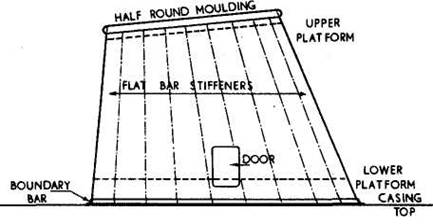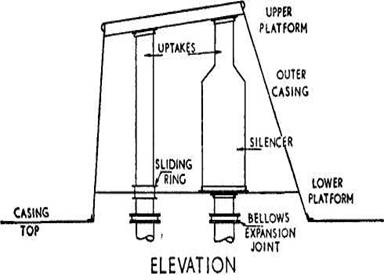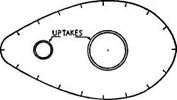Question
Describe with
detailed Sketch the Arrangement for securing the exhaust gas uptakes in the
funnel casing of a steam or motor ship
Answer.
The size and shape of the
funnel depends upon the requirements of the ship owners. At one time tall
funnels were fitted to steam ships to obtain the required natural draught and,
in passenger ships, to ensure that the smoke and grit were carried clear of the
decks. Modern ships with forced draught do not require such high funnels. The
funnel has now become a feature of the design of the ship, enhancing the
appearance and being a suitable support for the owners house mark. They are
built much larger than necessary, particularly in motor ships where the uptakes
are small. They may be circular, elliptical or pear shaped in plan view, while
there are many varied shapes in side elevation. In many cases the funnel is
designed to house deck stores or auxiliary machinery such as ventilating fan
units.
The funnel consists of an
outer casing protecting the uptakes. The outer funnel is constructed of steel
plate 6 mm to 8 mm in thickness. It is stiffened internally by ordinary angles
or flat bars fitted vertically. Their scantlings depend upon the size and shape
of the funnel. The plating is connected to the deck by a boundary angle, while
a moulding is fitted round the
top
to stiffen the free edge. Steel wire stays are connected to lugs on the outside
of the funnel and to similar lugs on the deck. A rigging screw is fitted to
each stay to enable the stays to be tightened. A watertight door is fitted in
the funnel, having clips which may be operated from both sides
(Fig. a).

Fig. a
FUNNEL CONSTRUCTION


PLAN VIEW
ARRANGEMENT OF FUNNEL UPTAKES
Fig. b
The uptakes from the
boilers, generators and main engine are carried up inside the funnel and
stopped almost level with the top of the funnel (Fig. b). A steel platform is
fitted at a height of about 1 m inside the funnel. This platform extends right
across the funnel, holes being cut in for the uptakes and access. The uptakes
are not connected directly to this platform because of possible expansion, but
a ring is fitted above and below the plating, with a gap which allows the pipe
to slide. Additional bellows expansion joints are arranged where necessary. At
the top a single platform or separate platforms may be fitted to support the
uptakes, the latter being connected by means of an angle ring to the platform.
In motor ships a silencer must be fitted in the funnel to the main engine
exhaust. This unit is supported on a separate seat. Ladders and gratings are
fitted inside the funnel to allow access for inspection and maintenance.